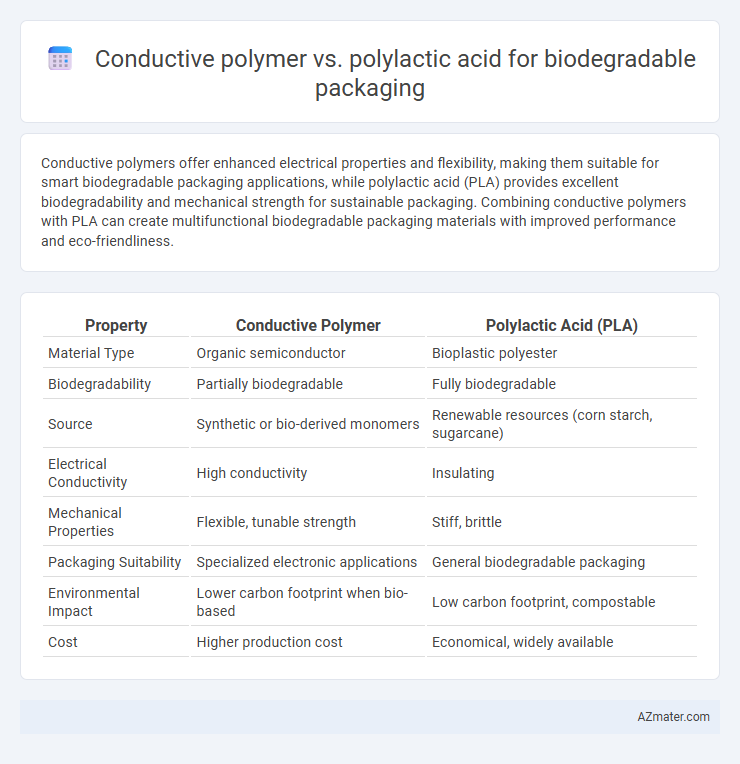Conductive polymers offer enhanced electrical properties and flexibility, making them suitable for smart biodegradable packaging applications, while polylactic acid (PLA) provides excellent biodegradability and mechanical strength for sustainable packaging. Combining conductive polymers with PLA can create multifunctional biodegradable packaging materials with improved performance and eco-friendliness.
Table of Comparison
| Property | Conductive Polymer | Polylactic Acid (PLA) |
|---|---|---|
| Material Type | Organic semiconductor | Bioplastic polyester |
| Biodegradability | Partially biodegradable | Fully biodegradable |
| Source | Synthetic or bio-derived monomers | Renewable resources (corn starch, sugarcane) |
| Electrical Conductivity | High conductivity | Insulating |
| Mechanical Properties | Flexible, tunable strength | Stiff, brittle |
| Packaging Suitability | Specialized electronic applications | General biodegradable packaging |
| Environmental Impact | Lower carbon footprint when bio-based | Low carbon footprint, compostable |
| Cost | Higher production cost | Economical, widely available |
Introduction to Biodegradable Packaging Materials
Biodegradable packaging materials are designed to decompose naturally through microbial activity, reducing environmental impact compared to traditional plastics. Conductive polymers offer innovative applications with electrical conductivity and biodegradability, making them suitable for smart packaging solutions. Polylactic acid (PLA) is a widely used biodegradable polymer derived from renewable resources like corn starch, valued for its compostability and mechanical strength in packaging.
Overview of Conductive Polymers
Conductive polymers, such as polyaniline and polypyrrole, offer unique electrical properties combined with biodegradability, making them promising materials for advanced packaging applications. Unlike polylactic acid (PLA), which is primarily valued for its compostability and mechanical strength, conductive polymers enable active packaging solutions with capabilities like sensing and antimicrobial activity. Research into integrating conductive polymers in biodegradable packaging aims to enhance functionality while maintaining environmental sustainability.
Properties and Applications of Polylactic Acid (PLA)
Polylactic acid (PLA) is a biodegradable polymer derived from renewable resources such as corn starch or sugarcane, characterized by its excellent transparency, high tensile strength, and compostability under industrial conditions. Its properties include good barrier resistance to oxygen and moisture, making it suitable for food packaging applications that require protection and freshness preservation. PLA's biocompatibility and ease of processing have expanded its use in disposable packaging, medical devices, and environmentally friendly agricultural films.
Environmental Impact: Conductive Polymer vs Polylactic Acid
Conductive polymers in biodegradable packaging offer limited environmental benefits due to their synthetic origin and complex degradation pathways, which can lead to persistent microplastic residues. Polylactic acid (PLA), derived from renewable resources like corn starch, exhibits superior compostability and lower carbon footprint, making it environmentally preferable for packaging applications. The lifecycle assessment of PLA shows reduced greenhouse gas emissions and enhanced soil biodegradability compared to conductive polymers, emphasizing its role in sustainable packaging solutions.
Mechanical and Physical Performance Comparison
Conductive polymers exhibit superior mechanical flexibility and electrical conductivity, making them ideal for smart biodegradable packaging that requires durability and functionality. Polylactic acid (PLA) offers excellent rigidity and good tensile strength but lacks inherent conductivity, limiting its use in active packaging applications. Comparing their physical performance, conductive polymers provide enhanced impact resistance and elongation, while PLA delivers better barrier properties and biodegradability under controlled composting conditions.
Biodegradation Rates and Processes
Conductive polymers typically exhibit slower biodegradation rates compared to polylactic acid (PLA) due to their synthetic backbone and complex molecular structure, which resist microbial breakdown. Polylactic acid undergoes hydrolytic degradation followed by microbial assimilation, resulting in a faster and more complete biotransformation under industrial composting conditions. The biodegradation process of PLA releases carbon dioxide and water, whereas conductive polymers may generate less environmentally benign byproducts, impacting their suitability for fully sustainable biodegradable packaging applications.
Cost Efficiency and Commercial Availability
Conductive polymers typically exhibit higher cost structures due to complex synthesis and limited large-scale production, which restricts their commercial availability compared to polylactic acid (PLA). PLA is widely produced from renewable resources like corn starch, offering a more cost-efficient solution for biodegradable packaging with established global supply chains. The widespread industrial adoption of PLA facilitates economies of scale, making it a commercially viable and economically attractive option in biodegradable packaging markets.
Suitability for Food Packaging Applications
Conductive polymers offer enhanced electrical properties and antimicrobial activity, making them suitable for active food packaging that requires sensing or preservation functions. Polylactic acid (PLA) is widely accepted in food packaging due to its biodegradability, safety, and excellent barrier properties for moisture and oxygen. While conductive polymers provide functionality beyond basic packaging, PLA remains the more practical choice for mainstream biodegradable food packaging due to regulatory approval and cost-effectiveness.
Innovations and Future Trends in Biodegradable Polymers
Conductive polymers offer innovative opportunities in biodegradable packaging by enabling smart packaging solutions with real-time sensing and electronic functionalities, enhancing product monitoring and safety. Polylactic acid (PLA) remains a leading biodegradable polymer due to its renewability and compostability, while ongoing research focuses on improving its mechanical properties and degradation rates through blending and copolymerization. Future trends emphasize hybrid materials combining conductive polymers with PLA to create multifunctional, eco-friendly packaging that supports both sustainability and advanced technological integration.
Conclusion: Choosing the Right Material for Sustainable Packaging
Conductive polymers offer enhanced electrical conductivity and functional versatility, making them suitable for smart packaging applications, while polylactic acid (PLA) provides excellent biodegradability and compostability, aligning with environmental sustainability goals. For biodegradable packaging focused primarily on reducing ecological impact, PLA remains the preferred choice due to its renewable origin and established composting infrastructure. Selecting the right material depends on balancing the need for functional performance with environmental considerations, where PLA excels in sustainability and conductive polymers serve niche applications requiring added electronic functionalities.

Infographic: Conductive polymer vs Polylactic acid for Biodegradable packaging
 azmater.com
azmater.com